Kimono Flea Market ICHIROYA's News Letter No.727

Hello, this is Mitsue.
2018 has started!! And we are already back from new year holidays. How was your holidays? I spent my holidays cleaning my house, washing clothes, and cooking and cooking... Every year, I prepare "Osechi Ryori" for New year's day to eat with family. It is a special time to eat traditional food all together.
"Osechi Ryori" is an assemble of colorful dishes packed together in special boxes called "Jubako". Since New Year holiday is a time for rest in Japan (according to tradition, nothing should be cooked on New Year’s Day), eating prepared Osechi Ryori is typical Japanese traditional custom. So I have to finish cooking during the New Year's eve. Many dishes containing a lot of sugar, soy source or vinegar are cooked in each house on this day.
Each foods of Osechi ryori are the most important meal of the year, as a symbol or wish for the coming year. The foods are eaten by using chopsticks that are rounded on both ends; one side for humans to use, one side for the gods. Let me introduce you the meanings behind some of the traditional osechi ryori.
*Kuromame (black soy beans)
In Japanese, “mame” also sounds like the word for “hard work and good health.” Eating this food during New Year's day is a symbol of good health for the coming year.
*Tai(sea bream) & Unagi(eel)
Eating grilled sea bream is a wish for happiness and eating grilled eel is a prayer for the success of rapid promotion.
*Ebi(shrimp)
Because of their long antennae and curved body, shrimp are a symbol of longevity. Shrimp is also a symbol of renewing life because they molt their skin.
*Kazunoko(herring roe)
Herring roe contains many tiny eggs in a tight. So it is eaten as a wish for an abundant harvest and fertility.
*Renkon(Lotus root)
Lotus root, with its many holes, is a symbol of an unobstructed view of the future.
*Gobo (burdock root)
Because the roots of the burdock plant grow deep into the ground and also represent a crane (the symbol of a fruitful year), burdock is eaten as a wish for good health and an abundant harvest.
*Kuwai(arrow head)
Sprout arrow head is a symbol of success, and it is often cut into hexagon and octagon like 'kikko' (tortoise shell) having a meaning of longevity.
*Kobu Maki (fish wrapped in seaweed)
The word, “kobu,” sounds like "yorokobu" meaning, “to be happy.” And rolled shape symbolizes a wish for scholarship and culture.
*Kamaboko (boiled fish‐paste)
The shape of Kamaboko is said to resemble the first sunrise of the New Year. In addition, the pink/red and white color of kamaboko is a good symbol because the color red is believed to be a talisman against evil and white signifies purity.
How do you like it? Would you like to eat some?

We also eat Ozoni(soup containing rice cakes and vegetables) on New Year's day. Soup is cooked in various ways according to regional custom. So the soup differ depending on which region the mother is from. My mother is from Ishikawa prefecture, and she usually cooked with white Miso.
We wish your new year will be happy, peaceful and healthy. Hope you enjoy Kimono life with ICHIROYA. Thank you!
We have some pieces with Osechi food design.
vegetable obi
fish & shrimp
furoshiki
fukusa
men's juban
nagoya obi
We wish you a happy new year from Ichiroya
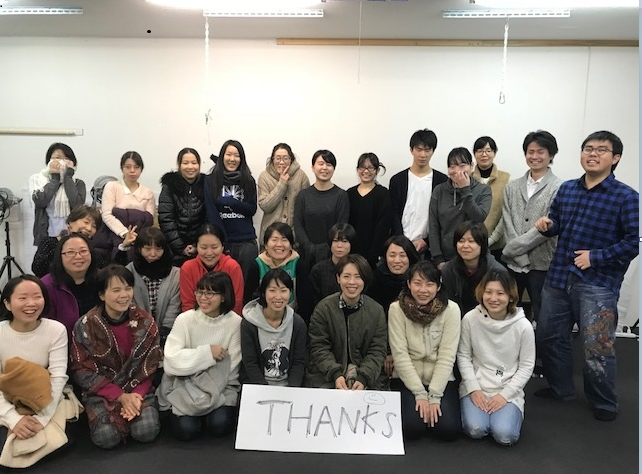
We like to thank you for shopping with us at Ichiroya.
dozo minasama yoi otoshio-we wish you a wonderful new year!
Ichiro & Yuka Wada
Kimono Flea Market "ICHIROYA"
http://www.ichiroya.com
e-mail: info@ichiroya.com
address: Asia-shoji Bldg.301
1841-1 Nishi 1 chome
Wakamatsu cho
Tondabayashi city
Osaka 584-0025 JAPAN
TEL&FAX ****( international number ) - 81-721-23-5446
Kimono Flea Market ICHIROYA's News Letter No.726

Hello! This is Nanae writing again. Well, um it's the holiday season.
Santa’s been checking his list to see who’s been naughty or nice and I'm kinda feeling guilty, so I wrote my last newsletter.
It’s freezing cold and was snowing two weeks ago in our city. My beloved dog cherishes a mini fan heater at my house. She finally started licking it. She is sleeping under the kotatsu (table w/ electric heater) right now. The photo above is taken at Ruri Koin and Fushimi Inari shrine in Kyoto two weeks ago as well. Ruri Koin is open for public only certain periods in spring and autumn. They still had beautiful red leaves there!

Actually I would like to introduce ‘Otsuka Museum of Art’ today.
The Otsuka Museum of Art is a "Ceramic board masterpiece art museum" with the largest exhibition space in Japan, built in Naruto City, Tokushima Prefecture. Inside, there are more than 1,000 replicas of priceless masterpieces of Western art, and collection from more than 190 art museums in 25 countries worldwide. These masterpieces are reproduced to their original size. The ceramic reproductions can maintain their color and shape for over 2,000 years!
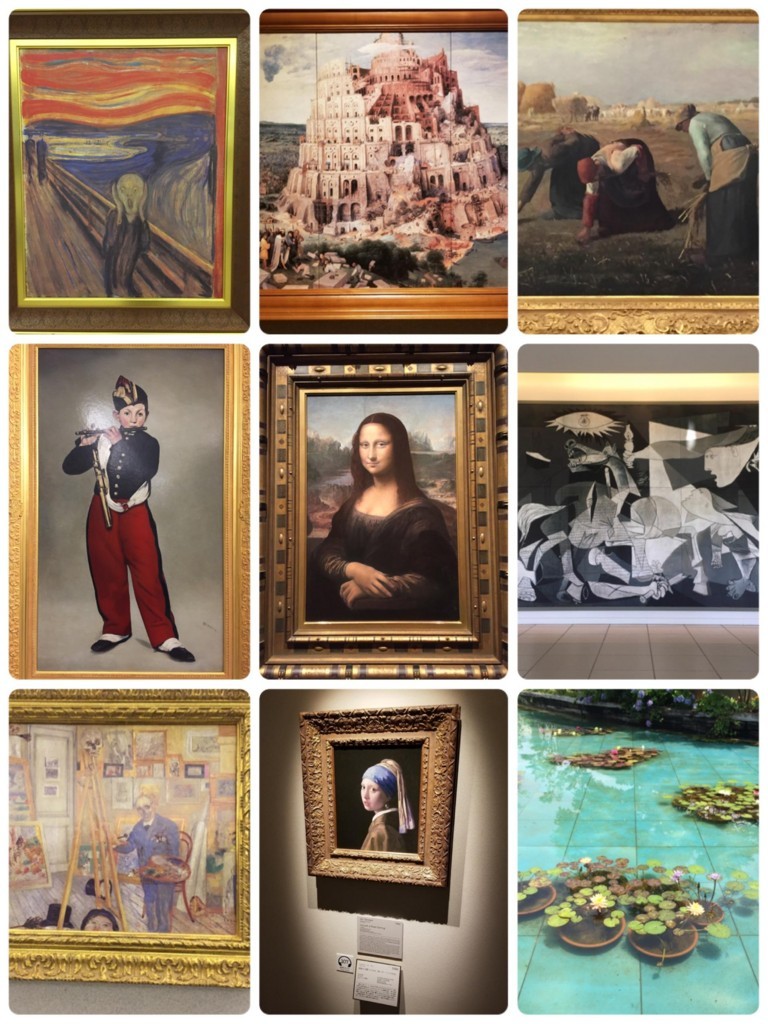
The good point is we can view Picasso’s Guernica, Scrovegni Chapel and Leonardo da Vinci’s Last Supper (before and after restoration), which can no longer be moved,
And also we can take pictures and even touch them like this,

This,

And this!

Some people say that Japan’s most expensive museum is full of fake art but it’s worth visiting it for both art lovers and beginners. I enjoyed doing what we cannot do with real paintings. My friends enjoyed finding paintings they know and tried to read a story from a ceiling picture of a chapel. I guess they love art much more than I! I'm a beginner :)

Photogenic!! Just at parking the area of the museum.
I still have many topics to share with you and lots of places to introduce but unfortunately this will be my last newsletter because I’m leaving Ichiroya.
Thank you for reading my limited newsletters. See you when I see you somewhere!
Best wishes for your happy kimono life with Ichiroya!
Today’s keyword, ‘ART’
<kimono>
www.ichiroya.com
<obi>
<others>
Kimono Flea Market ICHIROYA's News Letter No.724

Dear Newsletter readers,
Hello, this is Mari. It's my turn to write our weekly
newsletter. How are you doing?
YES, it is December! 2017 will be over soon. Every year,
we have last minutes Christmas shoppers at Ichiroya.
Please note that it is the busiest time at post offices all over the world. So, often times, even EMS can't be delivered on time.
Please understand we can't guarantee your Christmas gift will be delivered to you or your beloved on time. If you still want to take a chance, then go ahead to place order as soon as possible! DON'T FORGET TO CHOOSE EXPRESS SHIPPING!
The top picture was taken in the morning of my first day of the elementary school. In Japan, there is a entrance ceremony when you enter schools such as pre-school, elementary school, junior high, high school and University. It is common to dress up, and attend with parents to the ceremonies. My mother is wearing her Tsukesage kimono which she brought when she got married with my father. (I'm wearing a yellow suit. Believe it or not, my mother sewed it!)
It was common to wear Tsukesage or Houmongi and black haori for school events like entrance and graduation ceremony until 80's. Back then, kimono was more popular and close to our daily life than nowadays. I remember my mother was wearing wool kimono as her daily clothes when I was a child.
I wear my mother's kimono. However, the Tsukesage was not in my taste. Actually, none of her daughters wanted to wear it.
So, she decided to transform it to saruel pants!
Can you recognize that my mother is wearing pants which were made from the Tsukesage kimono?
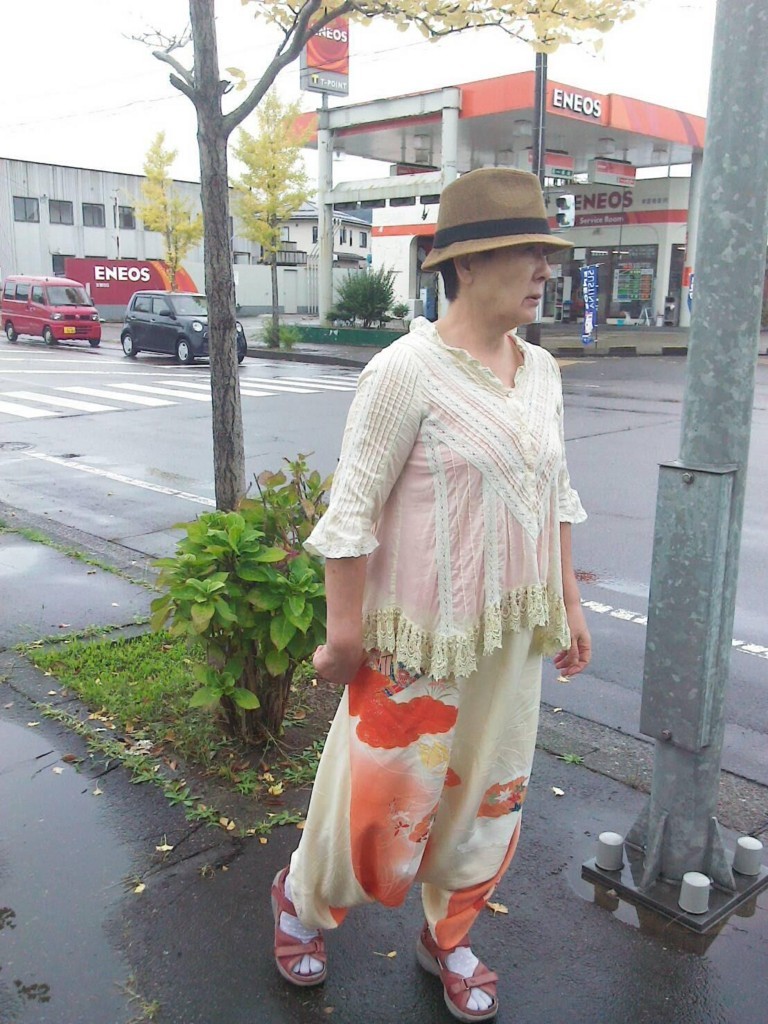
She has been making saruel pants for herself and her daughters. I have some. All of them were made from her old kimono, our childfood kimono, haori and kimono fabric bolt. The wide and loose silk saruel pants are very comfortable!

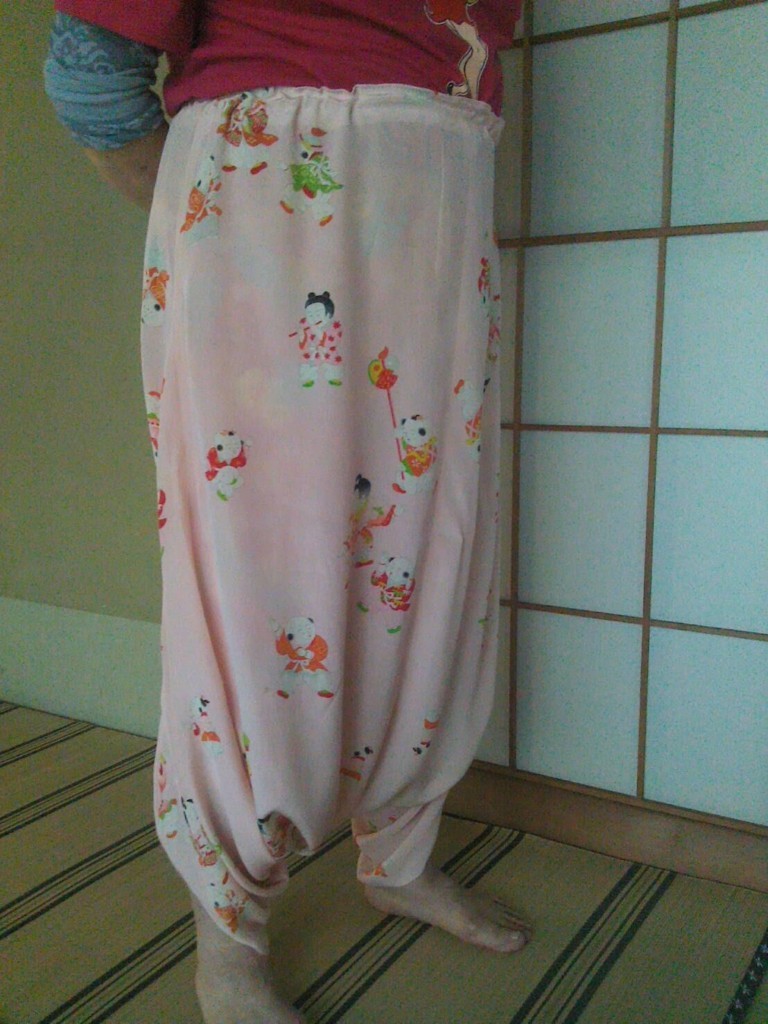
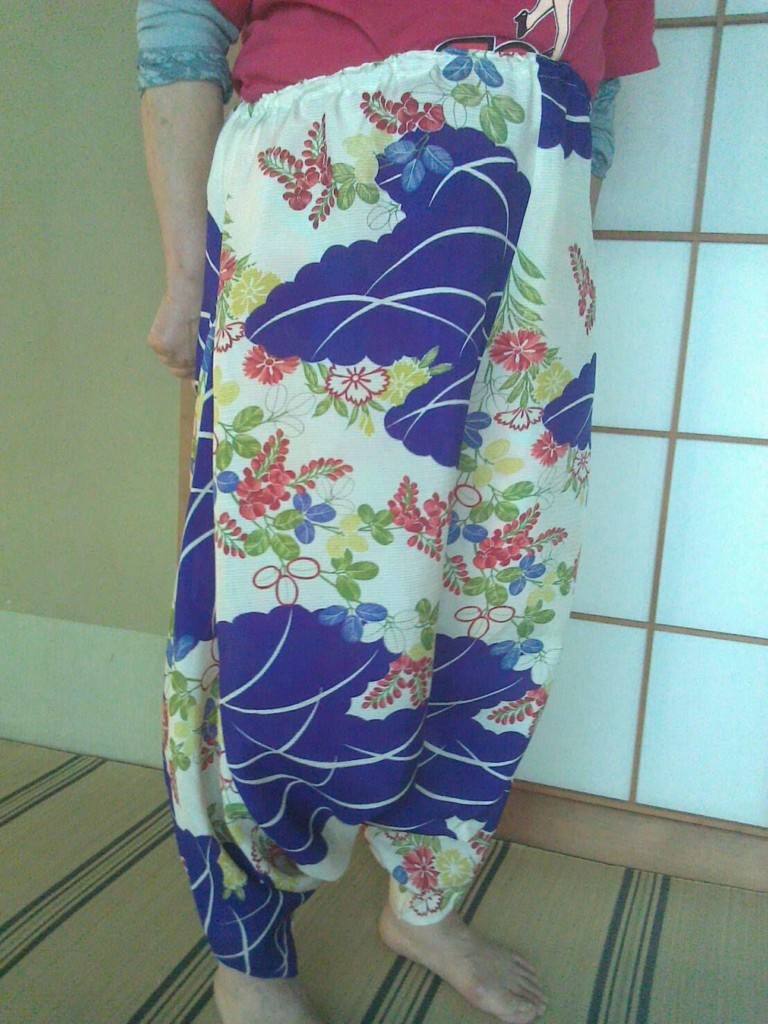
She wears the kimono saruel pants as her daily clothes. Also, she wears the pants at yoga lessons. Actually, she is a laughter yoga instructor. Those who have not heard about the unique kind of yoga, check Wikipedia out! It is very relaxing style of yoga which makes your daily life brighter, and your mind healthier.
She mainly teaches seniors. Many of them have not have a hearty laugh for long time. They even hesitate to laugh out loud in public. My mother says her Kimono pants are very useful to warm them up. They stair at her pants first. Then, start asking about them like, "Where did you get them?" " Well, are those made from Kimono?", "Did you make them by yourself?" etc. After they found out that she made them from her old kimono, they start talking about their kimono stories! Japanese seniors at their 60's and up used to wear kimono often when they are young. It was common to bring a huge chest of drawers full of kimono and obi when they got married. So, they talk about their kimono which have been avandoned in their chests for long time, just like my mother's Tsukesage kimono. By then, those seniors start laughing naturally. My mother said, if she wore just regular saruel pants, they wouldn't warm up like that. That's a power of kimono!
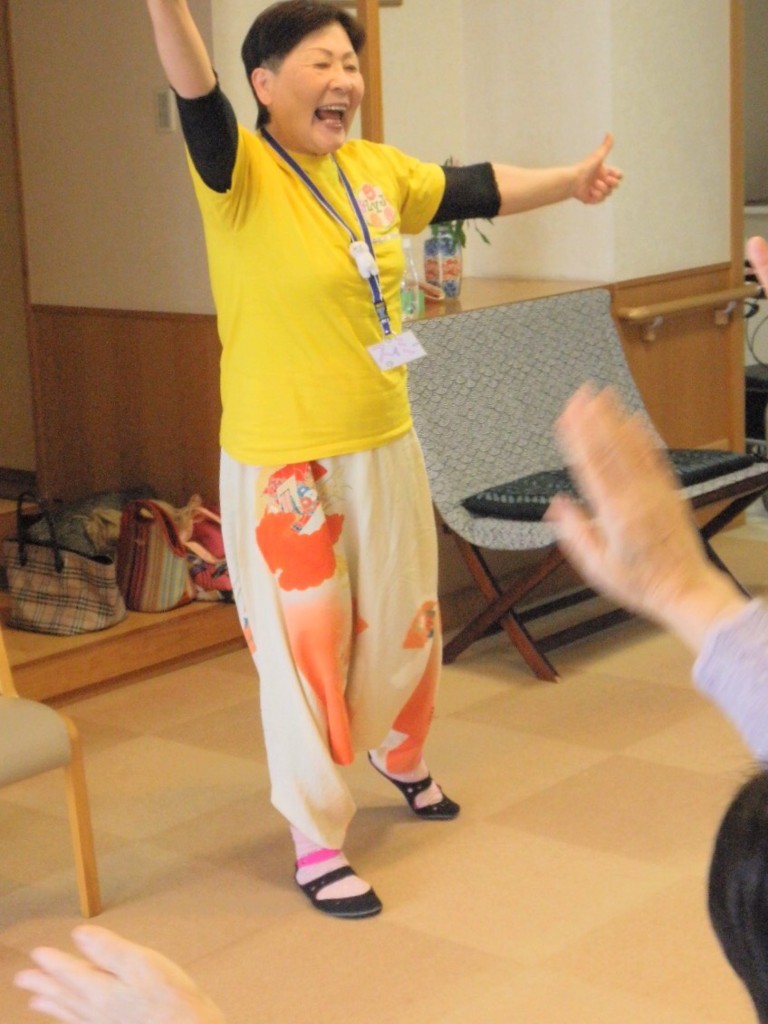
As we get used to wear Western clothes, we no longer wear kimono as we used to. Ichiroya encourage more people to wear kimono! We hope our reasonable price and easy access to kimono and obi help those kimono lovers and new to kimono people to wear kimono. At the same time, it sounds good to make something out of Kimono or kimono silk bolt! Wearing silk always make ladies feel special! Right?
My mother said it is easier to make the pants from bolt than kimono. It takes a lot time to unpick kimono. If you are thinking about making the pants, how about
the following bolts?
Kimono Flea Market ICHIROYA's News Letter No.723

Dear Ichiroya newsletter readers,
Konnichiwa!!! This is Yoko writing. Ogenki desuka?
Hope you are having a lovely weekend.
If you are planning a trip to Nagasaki or already live in Kyushu, we have a great news for you!!!
A good customer of Ichiroya has opened a vintage Kimono shop in China town of Nagasaki prefecture.
The store is called 'Antique Kimono Beppin' and owned by a petite charming lady Akemi Tagawa san.
She has a grand collection of vintage Kimono and Obi and has been collecting vintage items for a long time.
It is a shop you can visit and purchase, but it would be worth a trip just to see her superb collections!!! She already had exhibition in spring, here is the past newsletter about her exhibition'
Here is the flyer of her store'
https://www.instagram.com/p/BcI4MUAnyOM/?taken-by=kimonottefactory
Antique Kimono BEPPIN
Mashe-ru Tojin-saka 102
Kagomachi 6-3
Nagasaki-city, 850-0905
******************************

Back to today's newsletter topic!
Today I would like to write about the Katsushika Hokusai exhibition 'beyond the Mt. Fuji' which was held at Abeno Harukas Museum from October 6 to November 19.
Katsushika Hokusai is a Japanese artist, ukiyo-e painter and printmaker of the Edo period.
This particular event was a joint project with the British Museum, and we hear it was a great success in the UK this summer.
(Their title was 'beyond the Great Wave' how cool was that!!??)
Those who have not heard of Hokusai, you have surely seen his art works!!?? You instantly can be drawn into the world of Hokusai!!

The Hokusai exhibition in Japan was held ONLY in Osaka and also a HUGE success, it drew people from all over Japan.
I went on the last weekend of the exhibition, and from tweets and instagram, I knew it was going to be packed!
So I left home early and arrived at 9:00am to get in a line when the museum's open hour was at 10:00am!!
There was already a long line before the gate.... (sigh).... but the museum decided to open their door early!!, we were able to get in quickly!! yokatta!
The exhibition was AMAZING!
The woodblock prints and hand drawings of his works from 1779 to 1849 were displayed.
There was a total of about 200 of his works displayed, and about 1/3 of them was his own hand paintings.
Hokusai's famous original woodblock print of 'the Great Wave' and 'the Mt. Fuji' were displayed too.
Oh! by the way, they were a lot smaller than I imagined.
His rather off-scale and somewhat imaginary design took my breath away.
I was SO glad that I went to this exhibition as his detailed work, even a small expression of a farmer's face, was something I could not notice via photos and books.
The colors and its invisible power what emerges out were not something I could feel either if I never went. :)
All his works were amazing, even a miniature drawing on a note was stunning, but what I most impressed by was his LAST work at his age 90.
The 'Tiger in snow' was displayed at the last end of the exhibition, and I felt like my tears were gushing when I saw this painting.
Expression of the tiger's face was soft, content yet somewhat lonesome .... like it is wanting but not wanting to go somewhere peaceful...hmmmm
I do not know much about arts and history, but I am so glad that I went to this exhibition.
If you find a Hokusai exhibition in your country, I strongly recommend that you make a trip and visit!
It is worth a trip I promise!!!!
Here are some of our items with ukiyo-e related motifs!!
arigato gozaimasu for reading!!
Happy Holidays to you and yours.

Kimono Flea Market ICHIROYA's News Letter No.722

Shimaenaga, Long-tailed Tit obidome buckle #363253 on Kimonotte collar #363626
KAWAII items from Ichiroya
Dear Ichiroya newsletter readers,
Hi! This is Nagisa writing again. How have you been? I went to Expo '70 Commemorative Park to watch a football game last Sunday. The Expo park is where the Japan World Exposition was held in 1970, and it's located in Suita city, Osaka. There is a huge park now, which has a lot of sports facilities, big events are often held there, and seasonal flowers are come into full bloom in each season here and there. So that, many people visit the park throughout the year, and I've been there many times since I was a child. Now is a good season to see autumn leaves!

Incidentally, my old school football team 'KG Fighters' won through to the national tournament. Congrats! However, my favorite NFL team Texans is... Sigh... I've been heartbroken by the news about two legendary players' injuries... I was almost started to fold a thousand cranes with grief... I went to Goou Jinja Shinto Shrine instead. It's one of the unique Jinja in Kyoto, which is enshrined the guardian of legs and lower back. People come there, and pray for someone's or their own good health or recovery from worries about legs or lower back. I prayed for their speedy recovery from the other side of the sea!

By the way, there are various types of guardians other than health, such as learning, victory, love, business, and money. They are enshrined at each Jinja throughout Japan, and we visit these Jinja and pray depending on our worries or desires. Also, going around temples and shrines, and collecting stamps called 'Goshuin' on a stamp book is popular among ladies in Japan. Why don't you try it if you come to Japan?
Here is the today's main theme finally! (Sorry, my introductory stories are always too long.) I've been taking part in a class once a week recently. I study there about Japanese language education for non native speakers. Lots of Japanese words are used as they are in the world now. Kimono, Sushi, Ninja, Emoji, and so on. 'Kawaii' is one of them. Have you ever used the words? There are some English words which mean 'Kawaii' such as charming, cute, pretty, adorable, and lovely. When I write descriptions of Kimono items, I sometimes wonder which word I should choose. Anyways, 'Kawaii' is a very useful word, especially young girls often use this word for everything. I also often hear that our boss Ichiro says 'Look! This vintage Kimono is very 'Kawaii', isn't it?'
We have many 'Kawaii' items at Ichiroya! They are also perfect for Christmas gift, too!
*Owl Otedama: #320438
*Hair Accessory & Earring: #390038-390040
*Kimonotte Han-eri collar
*Christmas Motif
Kimono Flea Market ICHIROYA's News Letter No.721

Hello, this is Mitsue writing. The air is getting cool and the leaves are turning red and yellow. Kyoto and Nara are so crowded with visitors to see autumn leaves. I planned to visit Nara next week, and Kyoto at the end of this month with my friends.
My teacher of erthu (2-stringed Chinese instrument played with a bow) lives in Kyoto, and she happened to see Maiko last week at Yasaka shrine. They attended fire prevention campaign and helped for passing out tissues for public to call out attention for beware of fire. My teacher says she doesn't see Maiko so often even if living in Kyoto. So, she might have screamed 'MAIKO Haaaaan!!!' in her mind. It is a title of a Japanese comedy movie! During day times, Maiko takes lessons to polish their performances. So, if you see Maiko during daytime, probably she is a tourist who dress like Maiko. There are Maiko transformation studios in Kyoto!


Maiko is an apprentice geiko (not exactly same as geisha). Their jobs consist of performing songs, dances, and playing the shamisen or the koto (traditional Japanese instruments) for visitors during supper. Maiko are usually aged 15 to 20 years old and become geiko after learning how to dance the traditional Kyomai dances, play the shamisen, and learning Kyo-kotoba (dialect of Kyoto), regardless of their origins.
At night, they go out to work. At high-quality Japanese-style restaurants or Japanese-style inn, they perform dances, songs, play the shamisen, and serve visitors with sake. Recently, their jobs have expanded to include visiting nursing institutions or hospitals. Some maiko are also dispatched overseas.
Maiko originated from women who served green tea and dango (Japanese dumpling made from rice flour) to people who visited the Kitano Tenmangu or Yasaka Shrine (these are the two of the famous shrines in Kyoto) at teahouses about 300 years ago. At first, women served only green tea and dango, but they gradually started to perform songs and dances for visitors.
The hair style of Maiko has various kinds of Nihon gami(Japanese traditional hairstyles) depending on rank, formality and occasion. They decorate their hairstyles with seasonal kanzashi (traditional hair ornaments). Maiko, unlike geiko, use their own hair and not wigs. They go to the nihongami hairdresser once a week which means that they have to sleep on a takamakura (wooden block with a pillow) in order to maintain it.
Maiko wear special kimono called Susohiki or Hikizuri. They are usually 200cm long, with a padded hem to create weight so it will trail beautifully on the floor. When she walk outside, she will hold the bottom up with her hands, or tie it so that it does not touch the ground. The sleeves are long like those of a furisode. The kimono has colorful and seasinal pattern. For formal occasions the maiko will wear black Susohiki with 5 family crests of Okiya (house which she belongs to).
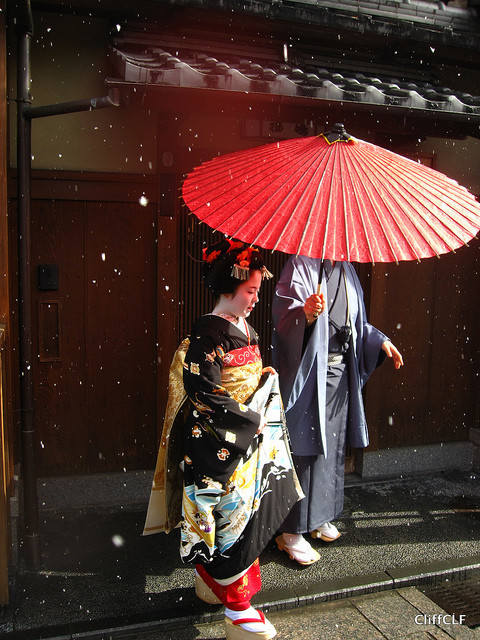
The darari obi is a 6-7 meters long obi worn by maiko. Due to its length and weight an otokoshi-san (male dresser) is needed to tie it. At the end of the darari obi has a crest, so that every one can see which okiya the maiko belongs to. For formal occasions the maiko will wear gold obi.

I wish I could take a photo some day....(haha!)
ICHIROYA has some pieces which have been worn by Maiko or Geiko. Please tale a look! Thank you for reading.
Susohiki for Maiko
http://www.ichiroya.com/item/list2/386119/
http://www.ichiroya.com/item/list2/372325/
Susohiki
http://www.ichiroya.com/item/list2/380124/
http://www.ichiroya.com/item/list2/284148/
http://www.ichiroya.com/item/list2/288034/
http://www.ichiroya.com/item/list2/380748/
Han-eri(additional collar)
http://www.ichiroya.com/item/list2/329062/
http://www.ichiroya.com/item/list2/347697/
http://www.ichiroya.com/item/list2/310744/
Obi
http://www.ichiroya.com/item/list2/355639/
Juban
http://www.ichiroya.com/item/list2/371977/